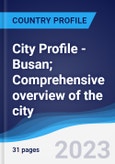The report contains detailed tourism, retail, construction, technology and public infrastructure data and insight into economic, social, and industry trends.
The GDP of Busan slowed down to 2.3% in real terms in 2022 and accounted for 4.7% of the South Korea’s GDP. Busan large scale civil engeneering projects such as the Eco Delta City and the port redevelopment, alongside the recovery of the real estate market expected to thrive the regional economy in the long-run
Scope
- The service sector remains the key contributor to the regional economy and the major employer in 2022.
- Busan has emerged as a premier tourist destination in 2022, attracting both business and leisure travelers with its stunning landscapes and cultural attractions. However, the construction sector experienced a decline in 2022 due to decrease in private construction investment.
Reasons to Buy
- Gain a comprehensive knowledge of future economic and demographic trends and understand the performance of various sectors within the city.
- Analyze and understand the business environment in the city to align your investment and expansion strategies.
- The report helps to drive a conclusion in choosing a suitable city to invest or expand according to your business structure.
- Explore new opportunities in the hospitality, tourism, construction, real estate and retail sectors.








